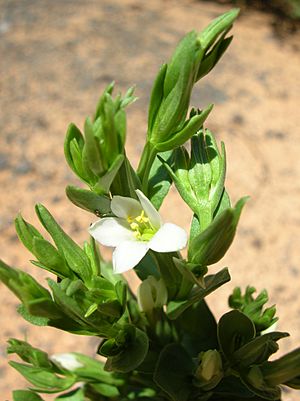Schenkia sebaeoides facts for kids
Quick facts for kids Schenkia sebaeoides |
|
|---|---|
 |
|
| Conservation status | |
| Scientific classification | |
| Genus: |
Schenkia
|
| Species: |
sebaeoides
|
| Synonyms | |
|
Centaurium sebaeoides (Griseb.) Druce |
|
Schenkia sebaeoides, known as ʻĀwiwi in Hawaiian, is a very rare flowering plant. In English, it is sometimes called lavaslope centaury. This special plant grows only in the Hawaiʻi islands in the United States. You can find it in dry, low shrubland areas.
ʻĀwiwi grows on the islands of Kauai, Oahu, Lanai, Molokai, and Maui. In 1991, it was added to the endangered species list. At that time, there were fewer than 1000 plants in total. The biggest danger to ʻĀwiwi is that its home is being destroyed.
Until 2004, this plant was part of the Centaurium group. Now, scientists have moved it to a new group called Schenkia. It is the only plant from the gentian family, called Gentianaceae, that naturally grows in Hawaii.
Contents
What is ʻĀwiwi?
ʻĀwiwi is a small plant that lives for only one year. This means it grows from a seed, flowers, makes new seeds, and then dies, all within a single year. Only about 3% of all Hawaiian plants have this kind of short life cycle.
Its Appearance
This plant often has white flowers. Sometimes, you might see pink flowers too. It can be a bit hard to spot because it looks similar to some common weeds. These weeds are called scarlet pimpernel and bitter herb. Because of this, ʻĀwiwi might grow in some places without anyone noticing it.
Its Life Cycle
The number of ʻĀwiwi plants changes a lot from year to year. There might even be small groups of plants that grow for just one season and then disappear. This plant likely has many seeds hidden in the soil. This is called a soil seed bank. When an area gets more rainfall, more of these seeds will sprout and grow.
Scientists check on the ʻĀwiwi plants every few years. The numbers they find can be very different each time. For example, in 2010, there were only about 52 plants on Kauai. But on Molokai and Maui, there were several thousand plants. Overall, during wet years, there might be around 6000 ʻĀwiwi plants in the world.
Where Does ʻĀwiwi Live?
This plant likes to grow in sand, volcanic soil, and clay soils. You can find it on bluffs and dunes in dry areas along the coast. It needs specific conditions to survive.
Why Is It Endangered?
Many things threaten the ʻĀwiwi plant. Its biggest problem is the invasion of plants that are not native to Hawaii. These are called invasive species.
Invasive Plants
Some of the worst invasive plants include Casuarina equisetifolia and C. glauca. These trees spread very quickly and grow so thick that smaller plants like ʻĀwiwi cannot get enough sunlight or space. Other harmful plants are Prosopis pallida and Bryophyllum pinnatum.
Each Hawaiian island has different invasive plants. So, the plans to protect ʻĀwiwi are different for each island.
Other Dangers
Many places where ʻĀwiwi lives are damaged by livestock like cattle and goats. These animals walk on the soil, making it hard and packed down. This can lead to erosion, where the soil washes away.
Off-road vehicles also cause damage by driving through the plant's habitat. Plants growing near hiking trails can be trampled by hikers. Wildfires are also a danger to some groups of ʻĀwiwi plants.


